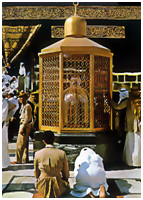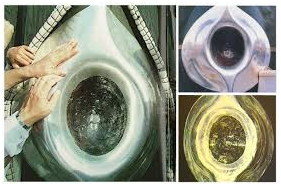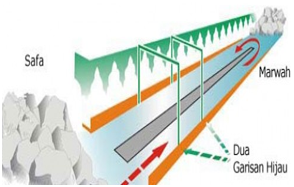MASJID E HARAAMA Masjid or Mosque is the building in which Muslims worship Allah سبحانه و تعالى. Throughout Islamic history, the mosque was the centre of the community and towns formed around this pivotal building. Nowadays, especially in Muslim countries mosques are found on nearly every street corner, making it a simple matter for Muslims to attend the five daily prayers.
Al-Masjid al- haraam is superior to any other mosques in the world. The best of all mosques is al-Masjid al-Haraam (The Sacred Mosque in Makkah), then al-Masjid al-Nabawi (the Prophet’sﷺMosque in Madeenah), then al-Masjid al-Aqsa (Bait ul Maqdis, Palestine).
These three mosques are the three for which it is prescribed to travel for the purpose of worship. The Prophetﷺsaid: “Do not travel or set out on journey(specifically) to any mosque except three: al-Masjid al-Haraam, Masjid al-Aqsa, and this mosque of mine.” Sahih al-Bukhaari, Vol.2: 1189, Vol.3: 1996 and Sahih Muslim 1397 [1]
History
Its ConstructionAllaah also says (interpretation of the meaning): “And (remember) when Ibraaheem and (his son) Ismaa’eel were raising the foundations of the House (the Ka’bah at Makkah)…” Quran Surah al-Baqarah 2:127
Wahb ibn Munbih said: “… It was built by Ibraaheem, then [rebuilt] by the Amalekites, then by Jurham, then by Qusayy ibn Kilaab. Its rebuilding by Quraysh is well known… They began to rebuild it with the stones of the valley, which Quraysh carried on their shoulders, and they built it up, 20 cubits high… Between the rebuilding of the Ka’bah and the beginning of the Revelation there were five years, and between the rebuilding and the Hijrah there were fifteen years. ‘Abd al-Razzaaq reported from Mu’ammar from ‘Abd-Allaah ibn ‘Uthmaan from Abu’l-Tufayl, and from Mu’ammar from al-Zuhri: ‘They were building it and when they reached al-Rukn, Quraysh argued about which tribe should lift it up. Then they said, “Let us ask the first person who comes from this direction to judge between us.” They agreed on that, then the Messenger of Allaah (peace and blessings of Allaah be upon him) came to them, and he was a young man wearing a spotted sash. They asked him to judge between them, and he told them to place al-Rukn on a piece of cloth, then he told the chief of every tribe to hold the edge of the cloth, then he climbed up and they lifted al-Rukn up to him, and he himself (peace and blessings of Allaah be upon him) put it into its place.” Taareekh Makkah by al-Azraqi, 1/161-164
There was no fence or wall around the Ka’bah until it became necessary. Yaaqoot al-Hamawi said in Mu’jam al-Buldaan (5/146): “The first one to build a wall around the Ka’bah was ‘Umar ibn al-Khattaab (may Allaah be pleased with him); there was no wall around it during the time of the Prophet (peace and blessings of Allaah be upon him) or Abu Bakr. [The wall was built] because people were building their houses too close to the Ka’bah and making the space around it too small for people. ‘Umar said: ‘The Ka’bah is the House of Allaah, and a house needs a courtyard. You have encroached on its space, it has not encroached on yours.’ So he bought those houses, demolished them and added that space to the space around the Ka’bah. He also destroyed the houses of people in the vicinity of the Ka’bah who had refused to sell, and kept the money aside for them until they came and took it later on. He built a wall around the mosque, lower than the height of a man, and lamps were placed on it. When ‘Uthmaan was khaleefah, he bought more houses that were more expensive… It was said that ‘Uthmaan was the first one to build porticos around it … When Ibn al-Zubayr was in power, he improved its appearance, although he did not increase its size, by adding marble pillars, extra doors and other improvements. When ‘Abd al-Malik ibn Marwaan was khaleefah, he added to the wall of the mosque, and brought columns from Egypt by sea to Jeddah, which were carried from Jeddah to Makkah on wheels. Al-Hajjaaj ibn Yoosuf commanded that the Ka’bah should be covered in drapes (al-kiswah) and when al-Waleed ibn ‘Abd al-Malik was khaleefah, he added to the adornment of the kiswah and spent money on improvements to the drainage spout and roof… When al-Mansoor and his son al-Mahdi were khaleefahs, they added more adornments to the mosque and improved its appearance.”
Before Prophet MuhammadBefore Prophet Muhammad (in the year in which the Prophetﷺwas born), the Ka’bah was subjected to an attack by the Ethiopian Abrahah, who had built al-Qulays, a church to which he wanted the Arabs to make their pilgrimage. He set out with his army, with whom was the elephant, and when they reached Makkah, Allaah sent flocks of birds against them; each bird was carrying three stones like chickpeas or lentils, one in its beak and two in its claws. Every man who was struck by a stone was killed, so the army was destroyed, by the command of Allaah.
Allaah has mentioned this incident in His Book, where He says (interpretation of the meaning): “Have you not seen how your Lord dealt with the Owners of the Elephant? Did He not make their plot go astray? And sent against them birds, in flocks, Striking them with stones of Sijjeel, And made them like an empty field of slaks (in which the corn has been eaten up by cattle).” Quran Surah al-Feel 105:1-5 (See al-Seerah al-Nabawiyyah by Ibn Hishaam, 1/44-58). [2] Current SituationA vast expansion project for the mataf, (the circumambulation space around the Kaaba), is currently under way. The new mataf when completed, after three years, will accommodate 130,000 pilgrims in an hour, while the current mataf capacity withstands 52,000 pilgrims.
Current ImamThe Grand Mosque’s Imam and Khatib, Sheikh Abdul Rahman Al-Sudais, who is also president of the Two sacred Mosques Affairs, said in a recent statement that Haj and Umrah pilgrims will not face any difficulties due to lack of space, after the completion of the expansion work. He also added they would have direct access to the mataf from the outer squares, without crossing the ground floor of the mosque. [3]
The first Mosque on EarthThis is the first mosque that was built for people on earth, as Allah says in the Qur’aan (interpretation of the meaning): “Verily, the first House (of worship) appointed for mankind was that at Bakkah (Makkah), full of blessing, and a guidance for al-‘aalameen (mankind and jinns).” Quran Surah Al’e ‘Imraan 3:96
It was reported by Abu Dharr(R) said: “I asked the Messenger of Allahﷺabout the first mosque to be built for people on earth. He said, ‘Al-Masjid al-Haraam.’ I asked, ‘Then which?’ He said, ‘Al-Masjid al-Aqsaa [The Furthest Mosque, in Jerusalem].’ I asked, ‘How long between them?’ He said, ‘Forty years.’” Sahih al-Bukhari Vol.4: 3366, Sahih Muslim 520 and Sunan Ibn Majah 753
Religious SignificanceQiblah or The direction for SalahThe Ka’bah – which is the direction of prayer for all Muslims throughout the world – is situated roughly in the middle of al-Masjid al-Haraam. It is a 15-meter high stone structure more or less in the shape of a cube. It was built by Ibraaheem (peace be upon him) on the command of Allaah. Allaah says (interpretation of the meaning): “And (remember) when We showed Ibraaheem the site of the (Sacred) House (the Ka’bah at Makkah) (saying): ‘Associate not anything (in worship) with Me, and sanctify My House for those who circumambulate it, and those who bow and make prostration.” Quran Surah al-Hajj 22:26
PilgrimageMuslims make major Pilgrimage or the specific journey to Makkah during the designated month of Dhul-Hijjah called as Hajj. Hajj is one of the five pillars of Islam and it is a religious obligation on every Muslim once in their life time for those who can afford it.
Allah said: Indeed, the first House [of worship] established for mankind was that at Makkah - blessed and a guidance for the worlds. In it are clear signs [such as] the standing place of Abraham. And whoever enters it shall be safe. And Hajj to the House is a duty that mankind owes to Allaah, those who can afford the expenses (for one’s conveyance, provision and residence); and whoever disbelieves [i.e., denies Hajj, then he is a disbeliever of Allaah]- then indeed, Allah is free from need of the worlds.Quran Surah Al’e Imran 3:96, 97
And proclaim to the people the Hajj [pilgrimage]; they will come to you on foot and on every lean camel; they will come from every distant pass. Quran Surah Hajj 22:27
Religious structures in and around Kaba Maqam E IbraheemThere are also other religious monuments in the Mosque, such as Maqaam Ibraaheem (the Station of Ibraaheem), which is the rock on which Ibraaheem (peace be upon him) stood whilst he was building the Ka’bah.
|
.

 Al-Masjid al-Haraam (the Sacred Mosque) is situated in Makkah, a city in the Arabian Peninsula 330 meters above sea-level. The history of the mosque goes back to its founding at the time of Ibraaheem (Abraham) and his son Ismaa’eel (Ishmael), peace be upon them both. Makkah is the place where the Prophet of Islam, Muhammad (peace and blessings of Allaah be upon him) was born and where the Revelation began, and from which the light of Islam spread. Al-Masjid al-Haraam is located in the city of Makkah, Saudi Arabia.
Al-Masjid al-Haraam (the Sacred Mosque) is situated in Makkah, a city in the Arabian Peninsula 330 meters above sea-level. The history of the mosque goes back to its founding at the time of Ibraaheem (Abraham) and his son Ismaa’eel (Ishmael), peace be upon them both. Makkah is the place where the Prophet of Islam, Muhammad (peace and blessings of Allaah be upon him) was born and where the Revelation began, and from which the light of Islam spread. Al-Masjid al-Haraam is located in the city of Makkah, Saudi Arabia.



 Makkah is the city where the first house of worship for Allah was built.
Makkah is the city where the first house of worship for Allah was built.